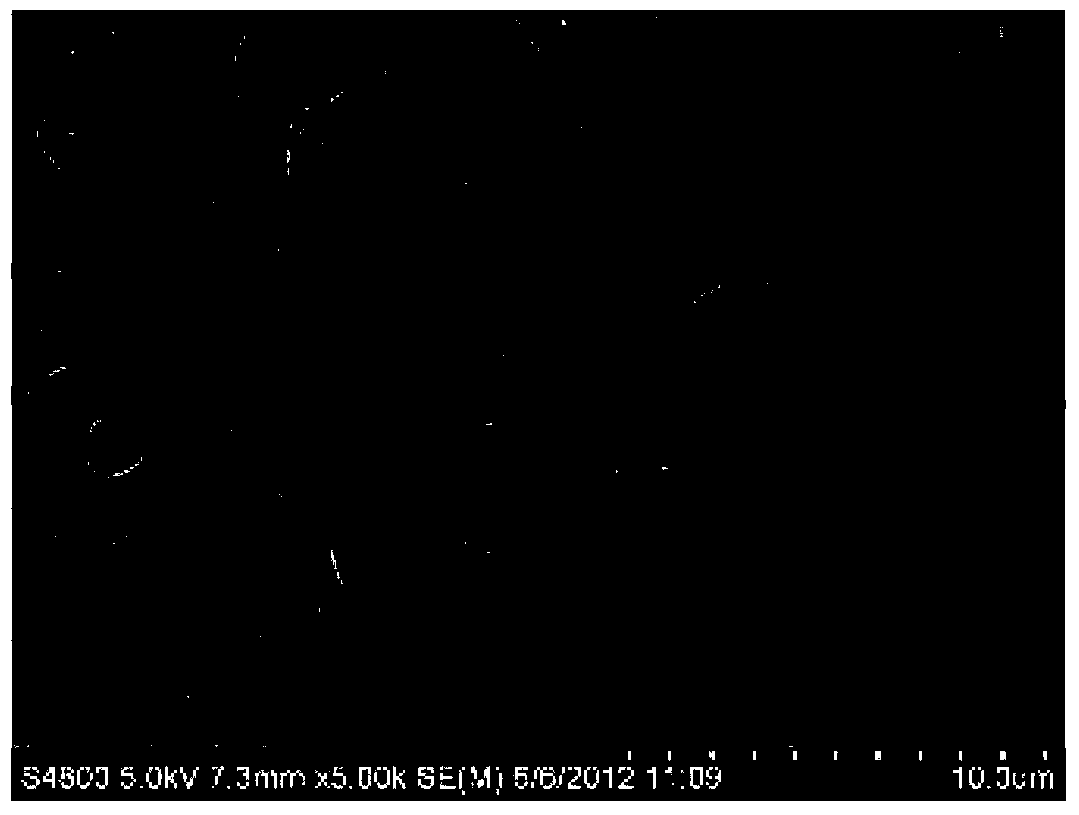Preparation method of lithium-titanate-cladding sulfur composite lithium-ion battery positive material
A lithium titanate-coated, lithium-ion battery technology, applied in battery electrodes, electrolyte storage battery manufacturing, non-aqueous electrolyte storage batteries, etc., can solve the problems of unfavorable high-rate performance of batteries, poor mechanical stability of electrodes, and large volume changes , to achieve good chemical stability and thermal stability, stable charge and discharge voltage platform, and easy preparation
- Summary
- Abstract
- Description
- Claims
- Application Information
AI Technical Summary
Problems solved by technology
Method used
Image
Examples
Embodiment 1
[0024] Example 1: Preparation of erythrocyte-like lithium titanate material
[0025] (1) Add 30 g of acetic acid and 50 g of tetrabutyl titanate in sequence to 300 ml of ethanol, and disperse with ultrasonic waves for 40 minutes to form A solution;
[0026] (2) Add 50 grams of acetic acid to 60 milliliters of ethanol, then add 30 milliliters of deionized water and 7.76 grams of lithium acetate to form B solution;
[0027] (3) After magnetically stirring solution A at a constant temperature of 30°C for 30 minutes, add solution B to solution A dropwise to obtain a sol;
[0028] (4) Add 1 gram of acetic acid to the sol obtained in step (3) to control the pH value at 1±0.1, and keep stirring for 1 hour to obtain the precursor sol;
[0029] (5) Import the precursor sol obtained in step (4) into a spray dryer, spray it into hot air, and form a precursor of erythrocyte-like lithium titanate material while removing most of the water;
[0030](6) Place the erythrocyte-like lithium ti...
Embodiment 2
[0031] Example 2: Preparation of lithium titanate-sulfur composite material
[0032] (1) Add 30 grams of citric acid and 50 grams of tetrabutyl titanate in sequence to 300 ml of ethanol, and disperse by ultrasonic for 40 minutes to form A solution;
[0033] (2) Add 50 grams of citric acid to 60 milliliters of ethanol, then add 30 milliliters of deionized water and 7.76 grams of lithium acetate to form B solution.
[0034] (3) After magnetically stirring solution A at a constant temperature of 30°C for 30 minutes, add solution B to solution A dropwise to obtain a sol;
[0035] (4) Add 10 grams of citric acid to the sol obtained in step (3) to make the pH of the sol 1±0.1, and keep stirring for 1 hour to obtain the precursor sol.
[0036] (5) The above-mentioned sol is introduced into a spray dryer, and the sol is dispersed into very fine mist-like particles by mechanical action. After contacting with hot air, most of the water is removed instantly to form a erythrocyte-like li...
Embodiment 3
[0039] Example 3: Lithium-sulfur battery with lithium titanate material as negative electrode material and lithium titanate-coated sulfur composite material as positive electrode material
[0040] The erythrocyte-like lithium titanate, acetylene black, and polyvinylidene fluoride (PVDF) in Example 1 were ground in a mass ratio of 80:10:10, and after grinding, the solvent N-methylpyrrolidone was added to adjust to a certain viscosity, and mechanically mixed for 30 Minutes, made into a paste, applied to the copper film, and dried in the shade; at 100 Kg cm -2 Press molding under a certain pressure to obtain the negative electrode of the lithium ion battery. (The manufacturing method of the negative electrode is different from that of the positive electrode)
[0041] The lithium titanate-coated sulfur composite material, acetylene black, and PVDF in Example 2 were ground in a mass ratio of 80:10:10, and N-methylpyrrolidone was added after each grinding to adjust to a certain vis...
PUM
 Login to View More
Login to View More Abstract
Description
Claims
Application Information
 Login to View More
Login to View More - R&D
- Intellectual Property
- Life Sciences
- Materials
- Tech Scout
- Unparalleled Data Quality
- Higher Quality Content
- 60% Fewer Hallucinations
Browse by: Latest US Patents, China's latest patents, Technical Efficacy Thesaurus, Application Domain, Technology Topic, Popular Technical Reports.
© 2025 PatSnap. All rights reserved.Legal|Privacy policy|Modern Slavery Act Transparency Statement|Sitemap|About US| Contact US: help@patsnap.com

